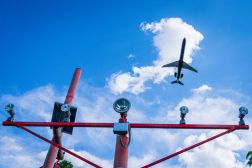The Federal Aviation Administration gave approval Tuesday to BP allowing the company to fly unmanned aerial vehicles in Alaska to survey pipelines remotely. This is the first time the FAA has allowed the operation of UAVs over land for commercial purposes.
Many Americans may look at UAVs, popularly referred to as drones, as modern weapons of war. Because of that, the thought of the futuristic systems flying around stateside tends to worry people. But the UAVs used for defense purposes and those that may one day may buzz around American skies are very different, and may revolutionize many commercial industries.
Nigel Ballard, Intel’s director of federal marketing, is a board member of Soar Oregon, a business initiative to bring UAV related investment and jobs to the state. A major advocate for UAV adoption in his state and beyond, Ballard said there’s ample opportunity for the commercial industry to drive the prevalence of drones.
“Even though the military have been using UAVs for a number of years, the commercial sector is really new territory,” Ballard said. “And the new territory scares people; the change is disconcerting for some and upsetting to others. But you have to accept the fact that the benefits, real and envisioned, so outweigh any potential downsides. [People] need to get [their] heads beyond militarized drones, which are actually an extremely small number.”
Ballard said there’s dozens of examples for drones to boost business and break into the commercial world. The most obvious, he said, is in precision agriculture. Farmers standing around their crops are too close to examine the hundreds of acres around them. Satellite imagery, however, is expensive, it may be old, and because of security concerns, the image quality is often reduced.
“What about an unmanned aerial vehicle with a hyperspectral or mutlispectral camera on it?” he asked. “That is perfect. In real time, I can see, and in near-real time, I can analyze the crops and tell you the nitrogen levels and whether I need to add fertilizer. Because of the infrared reflection of the leaves, I can actually tell the healthy plants from the non-healthy and take prescriptive actions.”
Extrapolating that across multiple farms in the U.S., the financial savings are huge, Ballard said. But also the reduction in harmful pesticides and fertilizers by intelligently analyzing crop growth has huge environmental impacts.
Wind turbines could see huge boosts in efficiency from UAV use as well.
“They’re gigantic things,” he said of the turbines. “And just like airplane fuselages, these things need to be checked for structural integrity and cracks.”
The old school method for checking them was to lock the blade and have experts climb to the top and inspect them, one massive blade at a time.
“It’s crazy, it’s kind of dangerous and it leads to the wind turbine being out of circulation for several days,” Ballard said. “Instead, you could take a UAV with a camera and do the same job in 20 to 30 minutes.”
Countless other industries could benefit from the use of UAVs: the oil industry in analyzing life-threatening parts of oil rigs, firefighters and law enforcement in aerial surveillance and analysis to reduce the cost of using a helicopter and avoid dangerous situations and Hollywood filmmakers want to use them for amazing and cost-effective aerial shots.
The problem is, the FAA hasn’t permitted any of these commercial industries to do so, now with the exception of BP in Alaska.
“It’s something the FAA is addressing,” Ballard said. “And they have to address it because there is a floodgate, and the floodgate is leaking more gallons of water an hour than it was just a day ago. The FAA needs to come up with a licensing or an exception or a set of rules to enable these entities to do things legally.”
The FAA must pass regulation on drone use by 2015, but it may happen sooner due to demand, Ballard said.
If not, “it will in some ways undermine the FAA,” he said. “The people have spoken and the people are starting to act. So the FAA needs to accelerate a decision because it’s not going to stop people. They need to step up to the plate and take a leadership role here, otherwise people will ultimately bypass them, and I don’t think that’s good for any side of the equation.”
Of course there are also the safety concerns that will need to be hashed out before that happens. A drone falling from the sky when it loses power or signal isn’t going to make anyone happy, nor is it when they feel like they’re being watched from above. But Ballard said there are many solutions — like sense and avoid technology and digital geo-fencing — in the works that could make the UAVs sophisticated devices buzzing around in the sky.
“It’s the least bit that industry can do for their part,” he said of the solutions. “There needs to be a way for these things to operate without putting people in harms way.”
Nevertheless, Ballard said the benefits seem to outweigh the concerns.
“UAVs are not going away. I hate to use the term, but ‘get used to it’ seems applicable,” he said. “The desire and need are immense, and the technological solution will be brought to bear. That’s what America’s really good at. If we can put a man on the moon, we can work out how to deliver a pizza to my backyard safely and securely.”






